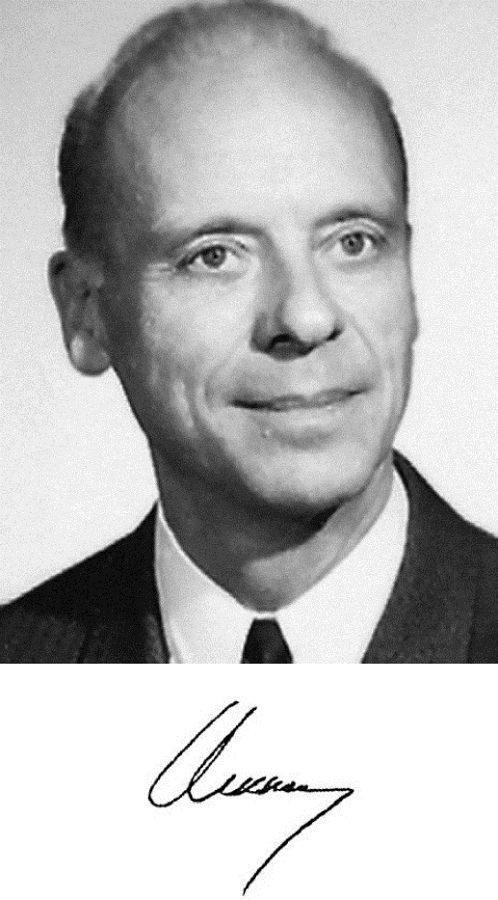CHARLES CRUSSARD
1916–2008
Elected in 1976
“Contributions to metallurgical science and technology and its applications.”
BY JEAN PHILIBERT SUBMITTED BY THE NAE HOME SECRETARY
CHARLES CRUSSARD, who died January 14, 2008, at age 91, devoted his career to research in metallurgy.
He was born June 24, 1916, the son and grandson of mining engineers—one of his grandfathers was the famous crystallographer Georges Friedel. He graduated first in his class from the École Polytechnique and completed his studies at the École des Mines in Paris. He then spent a few months at the Royal School of Mines in London, but his training there was interrupted by the war.
In 1942 he established a laboratory dedicated to metallurgical research at the École des Mines. With just a few collaborators he initiated research on plasticity, creep, and recrystallization of aluminum. Shortly after the end of World War II he managed to make a study trip to the United States to learn about new developments in metallurgical research, steel, powder metallurgy, and other areas. He completed his education at a summer school in Bristol (UK) organized by Sir Nevill Francis Mott.
He then spent a year in India, helping to organize the new National Metallurgical Laboratory in Jamshedpur, a laboratory officially unveiled in 1950 by Pandit Jawaharlal Nehru. Back in France, he joined the French Steel Research Institute (IRSID) as head of the physics department and, later, research director.
At both the École des Mines and IRSID, he was active in several fields that he personally initiated. He led studies on plastic deformation of aluminum and its alloys, single crystals and polycrystalline specimens, and the structure and properties of grain boundaries—a topic to which he introduced Jacques Friedel (a cousin), who went on to become famous in solid state physics.
Crussard discovered several new phenomena related to what came to be called polygonization, namely in situ recrystallization, polygonization during creep, and grain boundary migration. He developed the measurement of thermoelectric power as a tool to study the structural evolution of light alloys and steels—a method that was unfortunately forgotten and “rediscovered” 30 years later by younger scientists!
He maintained a strong interest in the martensitic transformation of steel, a phenomenon to which he introduced the author of this tribute. He launched with his collaborators several new fields of research, most notably the micromechanisms of fracture—a spectacular development known as “microfractography” thanks to a new tool, the electron microscope—and the study of crystallographic textures in steels, mainly used for the control of deep drawing of metallic sheets.
In parallel to those studies, he conducted personal work in the theoretical description of thermal activation as a nucleation process, the atomic structure of dislocations, the rheology of creep, properties of point defects, and the yield point (elastic limit) of steels. This brief listing shows the very broad array of interests, basic and applied, in which he revealed his remarkable abilities.
Yet despite his very successful research management at IRSID, in 1963 Charles Crussard chose to follow a different career: he was appointed scientific director of Pechiney, the French aluminum company. With his new responsibilities, he devoted a lot of effort to the coordination of research in a large group in several places with different traditions. This is the reason he decided to create a central research laboratory with important equipment (the so-called CRV, situated in Voreppe, near Grenoble), a laboratory that grew rapidly and
became famous among metallurgists all over the world. He made important contributions to aluminum extractive metallurgy, powder metallurgy, recrystallization and the formation of aluminum alloys, and metallic surfaces, to name a few.
He was also active in many national and international institutions. Of particular note, he was one of the first members of the International Deep Drawing Research Group (IDDRG; president, 1960–1964) and the European Industrial Research Management Association (EIRMA). These and his other international responsibilities were made easier thanks to his associations with scientists all over the world. After he retired in 1983 he gradually decreased his involvement in French and international committees.
He was the author or coauthor of 180 papers. His wealth of activities as a research scientist and manager justifies the many distinctions with which he was honored in France and abroad: several French medals and awards, fellowship in the American Society for Metals, and election as a foreign associate of the US National Academy of Engineering.
Charles Crussard made a strong and lasting impact on metallurgical research, in fundamental fields as well as applied and industrial domains. Such richness and breadth of initiatives and results were certainly due to his bright intellect, his deep knowledge of physics, and his creativity, as well as his many contacts and associations with foreign scientists and engineers, especially in Great Britain and the United States. He was a gentleman, scientist, and engineer.
Reference
Crussard C, Friedel J, Philibert J, Plateau J, Pomey G. 2009. L’œuvre scientifique de Charles Crussard, 1916–2008. Paris: Presses des Mines.





